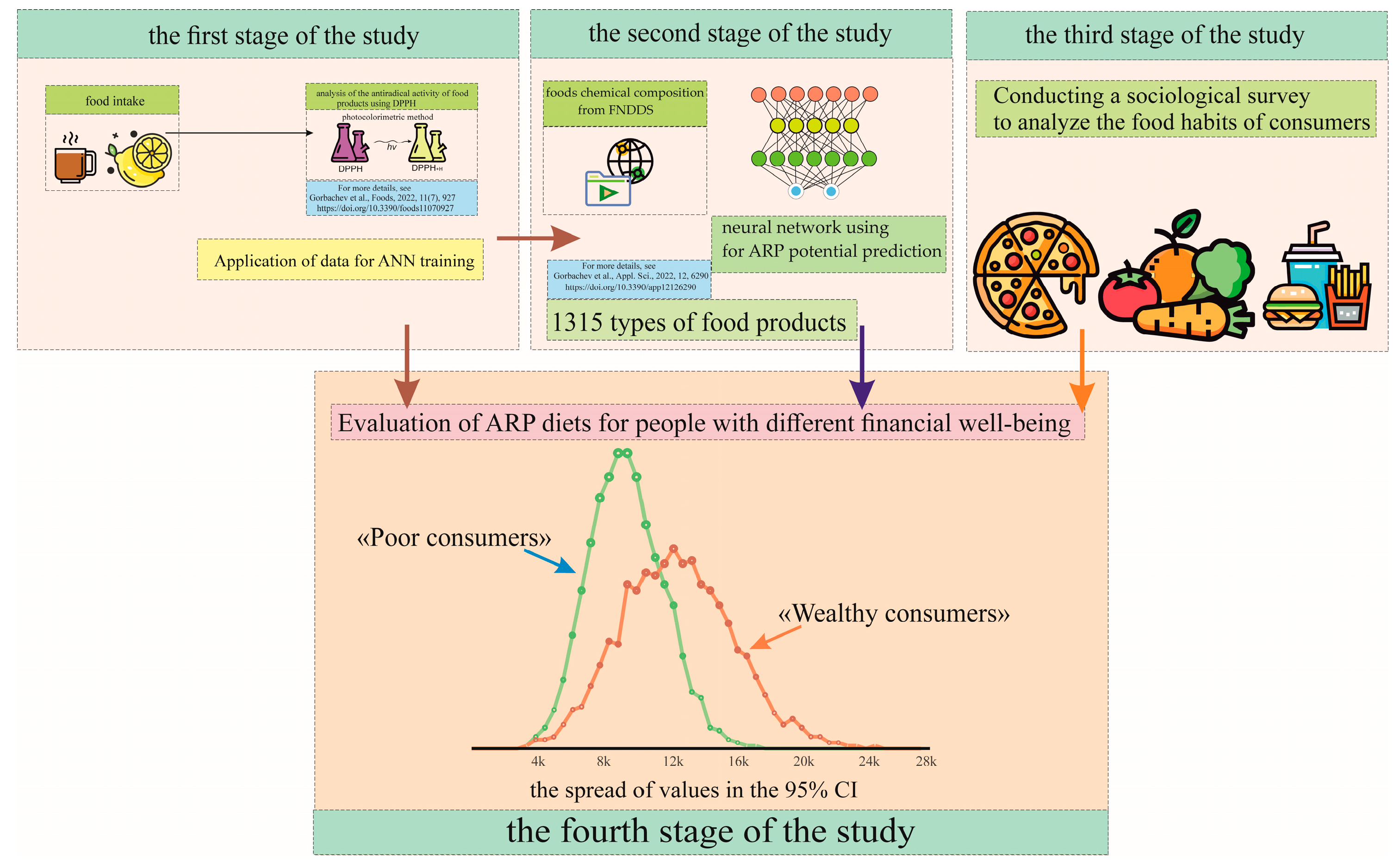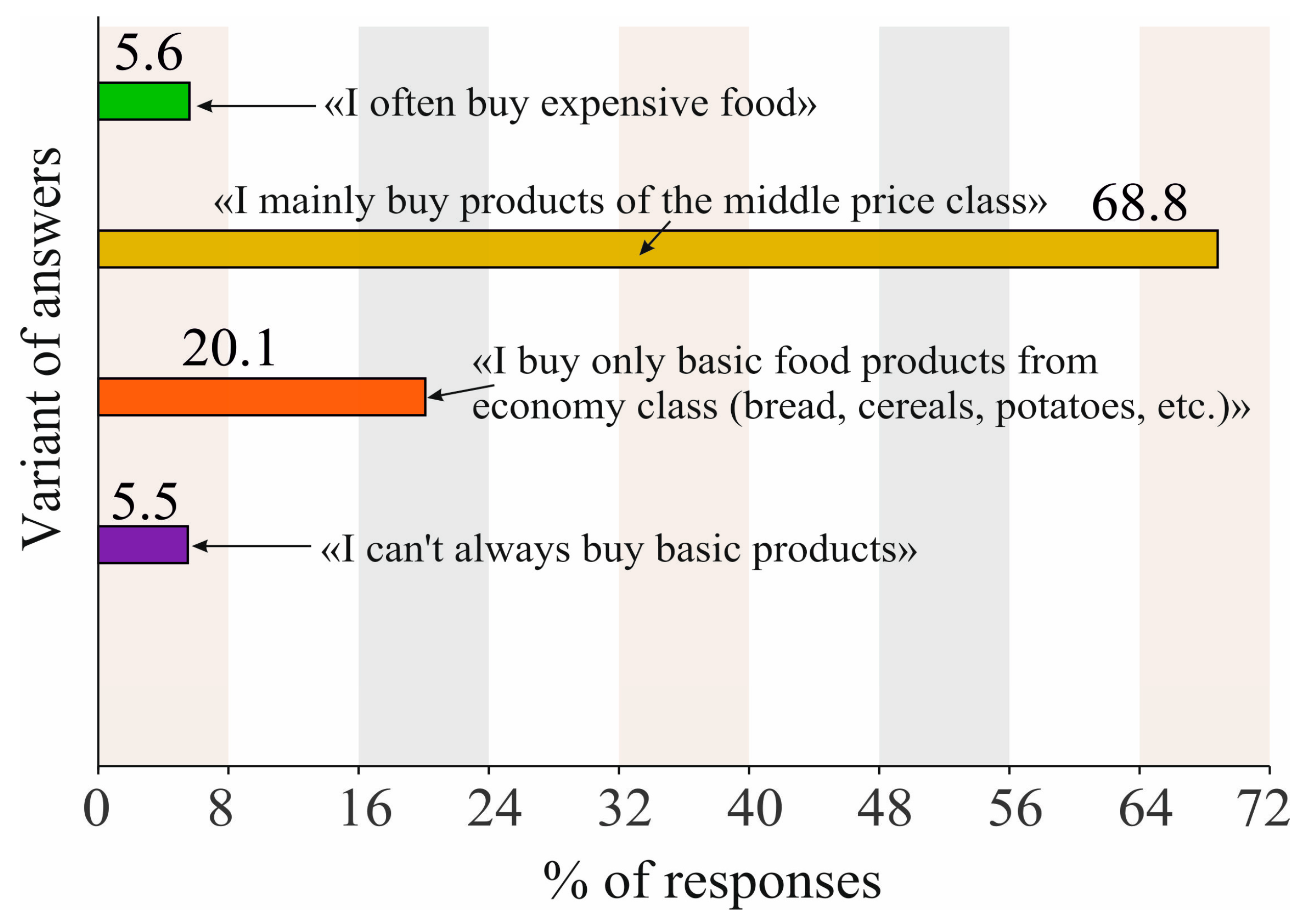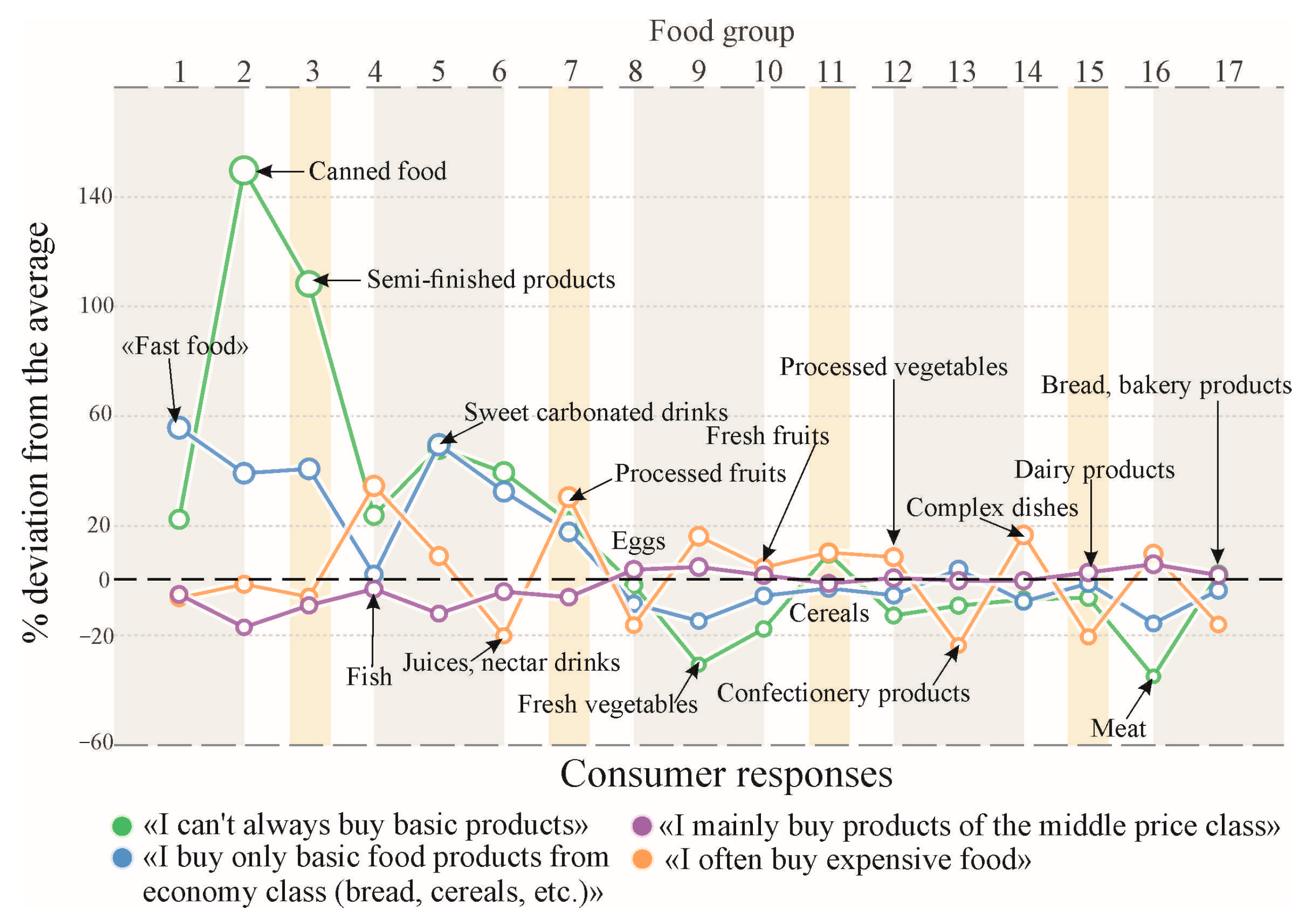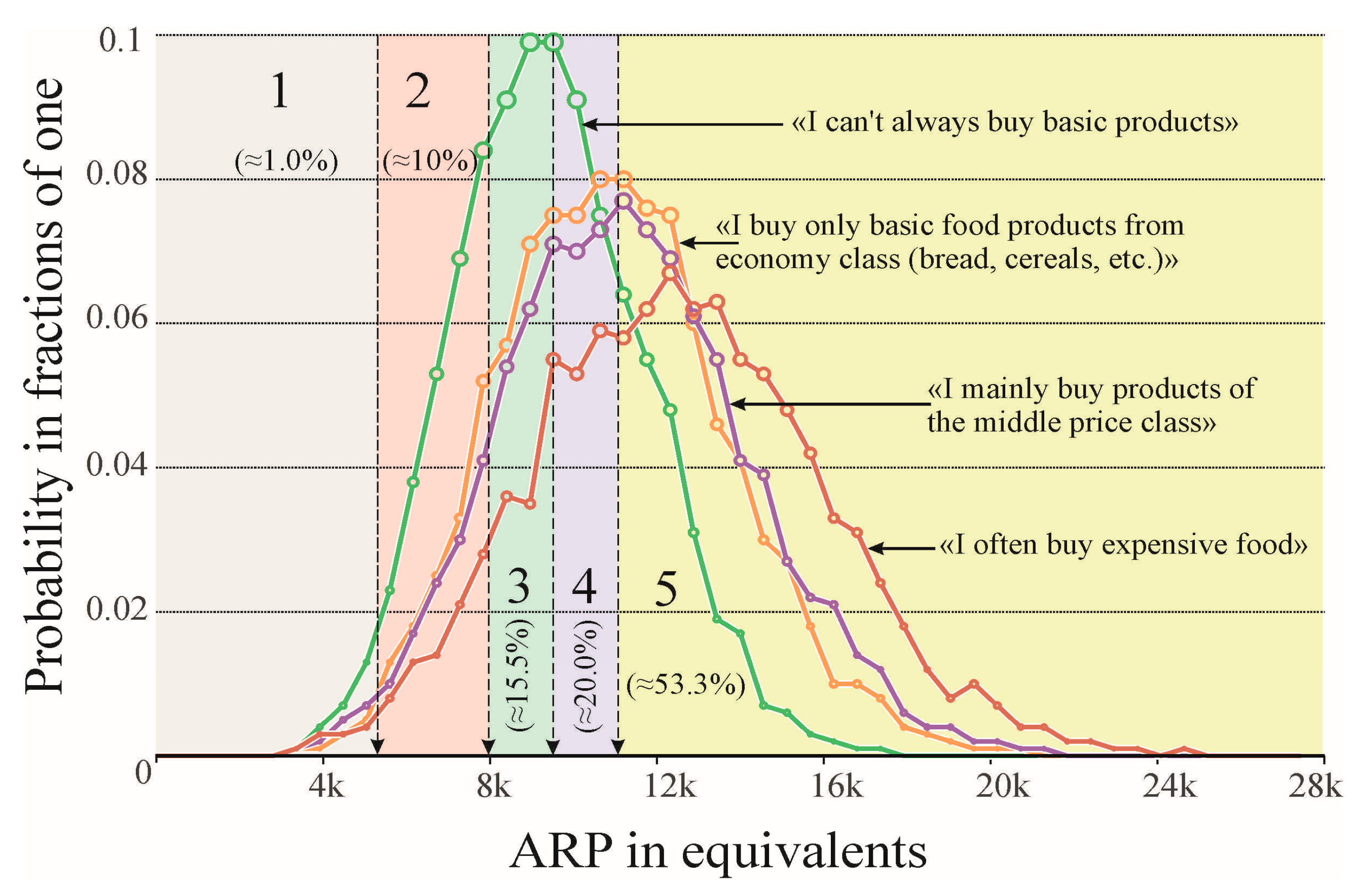The Impact of Social Well-Being on Population Diet Nutritional Value and Antiradical Status
Abstract
1. Introduction
2. Materials and Methods
3. Results and Discussion
4. Comparison with Published Data from Other Countries of the World
5. Conclusions
Author Contributions
Funding
Institutional Review Board Statement
Data Availability Statement
Conflicts of Interest
Appendix A
- Dairy products: yoghurts and fermented forms of milk and cream, including processed cheeses; milk; milk-based drinks (without milk substitutes); low-fat varieties and whole dairy products; human milk and baby food based on yoghurts, etc.
- Bread products: yeast bread; and bread with various additions and seasonings, including crackers, biscuits (not salty);
- Meat products: turkey, bacon, beef, liver and other internal organs, chicken, duck and other poultry, sausages, etc.; minced meat and other meat products; as well as baby food based on meat products;
- Cereals: barley, brown rice, white rice, mixed cereals, popcorn, cereals of various varieties, pumpkin seeds, pulses (lima, beans, etc.), nut seeds (peanuts, pistachio, almonds, etc.), and polygrain cereal bars;
- Confectionery: jam; marmalade; chewy, frozen sweets such as sherbets and fruit juices; ice cream toppings; sugary products made from grated fruits and nuts, sugar, syrups, pastes, etc., including those with sweeteners; caramels; puddings, including for baby food; muffins and sweet pastries; sweets; and chocolate products;
- Complex dishes, including those from the national cuisines of Italy, France, Mexico, England, etc., and Asian cuisine: puddings; pasta; pizza and pies with various fillings; mixed dishes of vegetables, meat, and cereals; salads and salad dressings; casseroles; ratatouilles; gnocchi and dumplings; burritos; chimichangas; French toast; stuffed strudel; baked dishes (meat and vegetables), including grilled dishes, soups, etc.;
- Processed vegetables: cooked vegetables; baked potatoes; French fries; tomatoes; tomato paste; canned, pickled or dried vegetables; as well as salads and mixed vegetable cuts; vegetable oils; and processed spinach, zucchini, and olives; fried onions and onion rings; white cabbage and broccoli, etc.;
- Fresh fruits: pineapples, apples, grapes, berries (blueberries, cranberries, strawberries), papayas, mangoes, etc.;
- Fresh vegetables: onions; carrots; greens (no specification); watercress; broccoli; starchy root vegetables, such as yams; sweet potatoes; beet leaf (chard), etc.;
- Eggs: chicken and egg products, boiled or fried in oil; and goose eggs (with preparation method separately taken into account: cooked yolks, poached eggs, and scrambled eggs);
- Processed fruits: dried mangoes; figs; banana chips; apple chips; tamarind; dried apricots; guava; lychee; plums; frozen pineapple; strawberries; salads including citrus fruits; as well as baby food with various pureed fruits, apples, pears, bananas, plums;
- Juices: citrus fruit and apple, including for baby food;
- Carbonated sweet drinks: those that are similar to energy drinks according to their ingredients, Cola, cream soda, pina colada and similar drinks depending on the country of origin (including with sweeteners), etc.;
- Semi-finished products, including frozen bread and flour products (for example, lasagna, pizza, etc.); meat, vegetable, or cereal products for cooking (nuggets, breakfast cereals for brewing hot water, frozen lunches), etc.;
- Canned food: fish, prepared canned soups, cheeses, stews, canned vegetables, legumes and grains.
- Menu from bistros (fast food eateries): fried potato, nuggets, beef stroganoff soups, burritos, hamburgers, cheeseburgers with various fillings, milkshakes, etc. (soda drinks may also be included);
- Fish: fish fillets; processed fish and seafood; representatives of various families, such as flounder, cod, herring, salmon, etc.
Appendix B
- A.
- Price
- B.
- Nutritional value
- C.
- Safety
- D.
- Shelf life
- E.
- Appearance, packaging
- F.
- Verified manufacturer
- G.
- Taste characteristics
- H.
- No chemical additives
- Daily
- I eat it every 2–3 days
- I eat it once a week
- I eat it less than once a week
- I practically do not eat it
- Daily
- I eat it every 2–3 days
- I eat it once a week
- I eat it less than once a week
- I practically do not eat it
- Daily
- I eat it every 2–3 days
- I eat it once a week
- I eat it less than once a week
- I practically do not eat it
- Daily
- I eat it every 2–3 days
- I eat it once a week
- I eat it less than once a week
- I practically do not eat it
- Daily
- I eat it every 2–3 days
- I eat it once a week
- I eat it less than once a week
- I practically do not eat it
- Daily
- I eat it every 2–3 days
- I eat it once a week
- I eat it less than once a week
- I practically do not eat it
- Daily
- I eat it every 2–3 days
- I eat it once a week
- I eat it less than once a week
- I practically do not eat it
- Daily
- I eat it every 2–3 days
- I eat it once a week
- I eat it less than once a week
- I practically do not eat it
- Daily
- I eat it every 2–3 days
- I eat it once a week
- I eat it less than once a week
- I practically do not eat it
- Daily
- I eat it every 2–3 days
- I eat it once a week
- I eat it less than once a week
- I practically do not eat it
- Daily
- I eat it every 2–3 days
- I eat it once a week
- I eat it less than once a week
- I practically do not eat it
- Daily
- I eat it every 2–3 days
- I eat it once a week
- I eat it less than once a week
- I practically do not eat it
- Daily
- I eat it every 2–3 days
- I eat it once a week
- I eat it less than once a week
- I practically do not eat it
- Daily
- I eat it every 2–3 days
- I eat it once a week
- I eat it less than once a week
- I practically do not eat it
- Daily
- I eat it every 2–3 days
- I eat it once a week
- I eat it less than once a week
- I practically do not eat it
- Daily
- I eat it every 2–3 days
- I eat it once a week
- I eat it less than once a week
- I practically do not eat it
- Daily
- I eat it every 2–3 days
- I eat it once a week
- I eat it less than once a week
- I practically do not eat it
- A.
- I often buy expensive food
- B.
- I mainly buy products of the middle price class,
- C.
- I buy only basic food products from economy class (bread, cereals, potatoes, etc.)
- D.
- I cannot always buy basic products
References
- Evenson, R.E.; Gollin, D. Assessing the Impact of the Green Revolution, 1960 to 2000. Science 2003, 300, 758–762. [Google Scholar] [CrossRef]
- Drewnowski, A.; Popkin, B.M. The Nutrition Transition: New Trends in the Global Diet. Nutr. Rev. 2009, 55, 31–43. [Google Scholar] [CrossRef]
- Koenen, M.; Hill, M.A.; Cohen, P.; Sowers, J.R. Obesity, Adipose Tissue and Vascular Dysfunction. Circ. Res. 2021, 128, 951–968. [Google Scholar] [CrossRef]
- Koliaki, C.; Liatis, S.; Kokkinos, A. Obesity and Cardiovascular Disease: Revisiting an Old Relationship. Metabolism 2019, 92, 98–107. [Google Scholar] [CrossRef] [PubMed]
- Clark, M.A.; Springmann, M.; Hill, J.; Tilman, D. Multiple Health and Environmental Impacts of Foods. Proc. Natl. Acad. Sci. USA 2019, 116, 23357–23362. [Google Scholar] [CrossRef] [PubMed]
- Barbato, E.; Noc, M.; Baumbach, A.; Dudek, D.; Bunc, M.; Skalidis, E.; Banning, A.; Legutko, J.; Witt, N.; Pan, M.; et al. Mapping Interventional Cardiology in Europe: The European Association of Percutaneous Cardiovascular Interventions (EAPCI) Atlas Project. Eur. Heart J. 2020, 41, 2579–2588. [Google Scholar] [CrossRef]
- Mendis, S.; Puska, P.; Norrving, B.; World Health Organization. World Heart Federation; World Stroke Organization Global Atlas on Cardiovascular Disease Prevention and Control; Shanthi, M., Ed.; World Health Organization: Geneva, Switzerland, 2011. [Google Scholar]
- Timmis, A.; Townsend, N.; Gale, C.P.; Torbica, A.; Lettino, M.; Petersen, S.E.; Mossialos, E.A.; Maggioni, A.P.; Kazakiewicz, D.; May, H.T.; et al. European Society of Cardiology: Cardiovascular Disease Statistics 2019. Eur. Heart J. 2020, 41, 12–85. [Google Scholar] [CrossRef]
- Barquera, S.; Pedroza-Tobías, A.; Medina, C.; Hernández-Barrera, L.; Bibbins-Domingo, K.; Lozano, R.; Moran, A.E. Global Overview of the Epidemiology of Atherosclerotic Cardiovascular Disease. Arch. Med. Res. 2015, 46, 328–338. [Google Scholar] [CrossRef] [PubMed]
- Martin, S.S.; Blaha, M.J.; Blankstein, R.; Agatston, A.; Rivera, J.J.; Virani, S.S.; Ouyang, P.; Jones, S.R.; Blumenthal, R.S.; Budoff, M.J.; et al. Dyslipidemia, Coronary Artery Calcium, and Incident Atherosclerotic Cardiovascular Disease: Implications for Statin Therapy From the Multi-Ethnic Study of Atherosclerosis. Circulation 2014, 129, 77–86. [Google Scholar] [CrossRef]
- Marles, R.J. Mineral Nutrient Composition of Vegetables, Fruits and Grains: The Context of Reports of Apparent Historical Declines. J. Food Compos. Anal. 2017, 56, 93–103. [Google Scholar] [CrossRef]
- Choi, B.H. Oxygen, Antioxidants and Brain Dysfunction. Yonsei Med. J. 1993, 34, 1. [Google Scholar] [CrossRef] [PubMed]
- Brieger, K.; Schiavone, S.; Miller, F.J., Jr.; Krause, K. Reactive Oxygen Species: From Health to Disease. Swiss Med. Wkly. 2012, 142, w13659. [Google Scholar] [CrossRef] [PubMed]
- Hooper, L.; Martin, N.; Jimoh, O.F.; Kirk, C.; Foster, E.; Abdelhamid, A.S. Reduction in Saturated Fat Intake for Cardiovascular Disease. Cochrane Database Syst. Rev. 2020. [Google Scholar] [CrossRef] [PubMed]
- Barja, G. Free Radicals and Aging. Trends Neurosci. 2004, 27, 595–600. [Google Scholar] [CrossRef]
- Di Meo, S.; Venditti, P. Evolution of the Knowledge of Free Radicals and Other Oxidants. Oxidative Med. Cell. Longev. 2020, 2020, 9829176. [Google Scholar] [CrossRef] [PubMed]
- Gorbachev, V.V.; Klokonos, M.; Mutallibzoda, S.; Tefikova, S.; Orlovtseva, O.; Ivanova, N.; Posnova, G.; Velina, D.; Zavalishin, I.; Khayrullin, M.; et al. Antiradical Potential of Food Products as a Comprehensive Measure of Their Quality. Foods 2022, 11, 927. [Google Scholar] [CrossRef]
- Kehrer, J.P.; Klotz, L.-O. Free Radicals and Related Reactive Species as Mediators of Tissue Injury and Disease: Implications for Health. Crit. Rev. Toxicol. 2015, 45, 765–798. [Google Scholar] [CrossRef] [PubMed]
- DiNicolantonio, J.J.; Lucan, S.C.; O’Keefe, J.H. The Evidence for Saturated Fat and for Sugar Related to Coronary Heart Disease. Prog. Cardiovasc. Dis. 2016, 58, 464–472. [Google Scholar] [CrossRef]
- Eng, J.M.; Estall, J.L. Diet-Induced Models of Non-Alcoholic Fatty Liver Disease: Food for Thought on Sugar, Fat, and Cholesterol. Cells 2021, 10, 1805. [Google Scholar] [CrossRef]
- Jensen, T.; Abdelmalek, M.F.; Sullivan, S.; Nadeau, K.J.; Green, M.; Roncal, C.; Nakagawa, T.; Kuwabara, M.; Sato, Y.; Kang, D.-H.; et al. Fructose and Sugar: A Major Mediator of Non-Alcoholic Fatty Liver Disease. J. Hepatol. 2018, 68, 1063–1075. [Google Scholar] [CrossRef]
- Temple, N. Fat, Sugar, Whole Grains and Heart Disease: 50 Years of Confusion. Nutrients 2018, 10, 39. [Google Scholar] [CrossRef] [PubMed]
- Lustig, R.H. Ultraprocessed Food: Addictive, Toxic, and Ready for Regulation. Nutrients 2020, 12, 3401. [Google Scholar] [CrossRef]
- Kawano, Y.; Edwards, M.; Huang, Y.; Bilate, A.M.; Araujo, L.P.; Tanoue, T.; Atarashi, K.; Ladinsky, M.S.; Reiner, S.L.; Wang, H.H.; et al. Microbiota Imbalance Induced by Dietary Sugar Disrupts Immune-Mediated Protection from Metabolic Syndrome. Cell 2022, 185, 3501–3519. [Google Scholar] [CrossRef] [PubMed]
- Gorbachev, V.; Nikitina, M.; Velina, D.; Mutallibzoda, S.; Nosov, V.; Korneva, G.; Terekhova, A.; Artemova, E.; Khashir, B.; Sokolov, I.; et al. Artificial Neural Networks for Predicting Food Antiradical Potential. Appl. Sci. 2022, 12, 6290. [Google Scholar] [CrossRef]
- Rauma, A.L.; Törrönen, R.; Hänninen, O.; Verhagen, H.; Mykkänen, H. Antioxidant Status in Long-Term Adherents to a Strict Uncooked Vegan Diet. Am. J. Clin. Nutr. 1995, 62, 1221–1227. [Google Scholar] [CrossRef]
- Alpers, D.H.; Bier, D.M.; Carpenter, K.J.; McCormick, D.B.; Miller, A.B.; Jacques, P.F. History and Impact of Nutritional Epidemiology. Adv. Nutr. 2014, 5, 534–536. [Google Scholar] [CrossRef]
- Khan, T.A.; Chiavaroli, L.; Zurbau, A.; Sievenpiper, J.L. A Lack of Consideration of a Dose–Response Relationship Can Lead to Erroneous Conclusions Regarding 100% Fruit Juice and the Risk of Cardiometabolic Disease. Eur. J. Clin. Nutr. 2019, 73, 1556–1560. [Google Scholar] [CrossRef]
- Boeing, H. Nutritional Epidemiology: New Perspectives for Understanding the Diet-Disease Relationship? Eur. J. Clin. Nutr. 2013, 67, 424–429. [Google Scholar] [CrossRef]
- Darmon, N.; Drewnowski, A. Contribution of Food Prices and Diet Cost to Socioeconomic Disparities in Diet Quality and Health: A Systematic Review and Analysis. Nutr. Rev. 2015, 73, 643–660. [Google Scholar] [CrossRef]
- Cena, H.; Calder, P.C. Defining a Healthy Diet: Evidence for the Role of Contemporary Dietary Patterns in Health and Disease. Nutrients 2020, 12, 334. [Google Scholar] [CrossRef]
- Gorbachev, V.; Nikulchev, E.; Kosenkov, A.N.; Sokolov, A.; Zavalishin, I.; Nikitin, I. Estimating the Mass of Food Components Necessary for the Utilization of Free Radical Particles in the Human Body. Int. J. Environ. Res. Public Health 2022, 19, 15574. [Google Scholar] [CrossRef] [PubMed]
- Montville, J.B.; Ahuja, J.K.C.; Martin, C.L.; Heendeniya, K.Y.; Omolewa-Tomobi, G.; Steinfeldt, L.C.; Anand, J.; Adler, M.E.; LaComb, R.P.; Moshfegh, A. USDA Food and Nutrient Database for Dietary Studies (FNDDS), 5.0. Procedia Food Sci. 2013, 2, 99–112. [Google Scholar] [CrossRef]
- Nestorowicz, R.; Jerzyk, E.; Rogala, A. In the Labyrinth of Dietary Patterns and Well-Being—When Eating Healthy Is Not Enough to Be Well. Int. J. Environ. Res. Public Health 2022, 19, 1259. [Google Scholar] [CrossRef]
- Watts, T.W.; Duncan, G.J.; Quan, H. Revisiting the Marshmallow Test: A Conceptual Replication Investigating Links between Early Delay of Gratification and Later Outcomes. Psychol. Sci. 2018, 29, 1159–1177. [Google Scholar] [CrossRef]
- Martinez-Gonzalez, M.A.; Estruch, R. Mediterranean Diet, Antioxidants and Cancer: The Need for Randomized Trials. Eur. J. Cancer Prev. 2004, 13, 327–335. [Google Scholar] [CrossRef]
- Steele, R. (Ed.) Understanding and Measuring the Shelf-Life of Food; CRC Press: Boca Raton, FL, USA, 2004; ISBN 978-0-8493-2556-4. [Google Scholar]
- Gorbachev, V.; Klokonos, M.; Orlovtseva, O.; Tefikova, S.; Nikitin, I. Analysis of Anti-Radical Activity of Some Food Suitable Algae of the Sea of Okhotsk. E3S Web Conf. 2021, 279, 03007. [Google Scholar] [CrossRef]
- Bennett, D.A.; Landry, D.; Little, J.; Minelli, C. Systematic Review of Statistical Approaches to Quantify, or Correct for, Measurement Error in a Continuous Exposure in Nutritional Epidemiology. BMC Med. Res. Methodol. 2017, 17, 146. [Google Scholar] [CrossRef]
- Carroll, R.J.; Freedman, L.S.; Kipnis, V. Measurement Error and Dietary Intake. In Mathematical Modeling in Experimental Nutrition; Advances in Experimental Medicine and Biology; Clifford, A.J., Müller, H.-G., Eds.; Springer US: Boston, MA, USA, 1998; Volume 445, pp. 139–145. ISBN 978-1-4899-1961-8. [Google Scholar]
- Mozaffarian, D. Dietary and Policy Priorities for Cardiovascular Disease, Diabetes, and Obesity: A Comprehensive Review. Circulation 2016, 133, 187–225. [Google Scholar] [CrossRef]
- Darmon, N.; Drewnowski, A. Does Social Class Predict Diet Quality? Am. J. Clin. Nutr. 2008, 87, 1107–1117. [Google Scholar] [CrossRef]
- Dave, D.M.; Kelly, I.R. How Does the Business Cycle Affect Eating Habits? Soc. Sci. Med. 2012, 74, 254–262. [Google Scholar] [CrossRef]
- Zasimova, L. The Association between Fast-Food Consumption and Job-Related Factors among Russian Adults. Econ. Hum. Biol. 2022, 46, 101147. [Google Scholar] [CrossRef] [PubMed]
- Zagorsky, J.L.; Smith, P.K. Who Drinks Soda Pop? Economic Status and Adult Consumption of Sugar-Sweetened Beverages. Econ. Hum. Biol. 2020, 38, 100888. [Google Scholar] [CrossRef] [PubMed]
- Bernsdorf, K.A.; Lau, C.J.; Andreasen, A.H.; Toft, U.; Lykke, M.; Glümer, C. Accessibility of Fast Food Outlets Is Associated with Fast Food Intake. A Study in the Capital Region of Denmark. Health Place 2017, 48, 102–110. [Google Scholar] [CrossRef] [PubMed]
- Holder, M.D. The Contribution of Food Consumption to Well-Being. Ann. Nutr. Metab. 2019, 74, 44–52. [Google Scholar] [CrossRef] [PubMed]
- Jain, A.; Sherman, S.N.; Chamberlin, D.L.A.; Carter, Y.; Powers, S.W.; Whitaker, R.C. Why Don’t Low-Income Mothers Worry About Their Preschoolers Being Overweight? Pediatrics 2001, 107, 1138–1146. [Google Scholar] [CrossRef]
- Rao, M.; Afshin, A.; Singh, G.; Mozaffarian, D. Do Healthier Foods and Diet Patterns Cost More than Less Healthy Options? A Systematic Review and Meta-Analysis. BMJ Open 2013, 3, e004277. [Google Scholar] [CrossRef]
- Galobardes, B.; Morabia, A.; Bernstein, M.S. Diet and Socioeconomic Position: Does the Use of Different Indicators Matter? Int. J. Epidemiol. 2001, 30, 334–340. [Google Scholar] [CrossRef]
- De Mestral, C.; Marques-Vidal, P.; Gaspoz, J.-M.; Theler, J.-M.; Guessous, I. Independent Association between Socioeconomic Indicators and Macro- and Micro-Nutrient Intake in Switzerland. PLoS ONE 2017, 12, e0174578. [Google Scholar] [CrossRef]
- Van Rossum, C.; Van De Mheen, H.; Witteman, J.; Grobbee, E.; Mackenbach, J. Education and Nutrient Intake in Dutch Elderly People. The Rotterdam Study. Eur. J. Clin. Nutr. 2000, 54, 159–165. [Google Scholar] [CrossRef]
- Groth, M.; Fagt, S.; Brøndsted, L. Social Determinants of Dietary Habits in Denmark. Eur. J. Clin. Nutr. 2001, 55, 959–966. [Google Scholar] [CrossRef]
- Turrell, G.; Hewitt, B.; Patterson, C.; Oldenburg, B. Measuring Socio-Economic Position in Dietary Research: Is Choice of Socio-Economic Indicator Important? Public Health Nutr. 2003, 6, 191–200. [Google Scholar] [CrossRef] [PubMed]
- Mishra, G.; Ball, K.; Arbuckle, J.; Crawford, D. Dietary Patterns of Australian Adults and Their Association with Socioeconomic Status: Results from the 1995 National Nutrition Survey. Eur. J. Clin. Nutr. 2002, 56, 687–693. [Google Scholar] [CrossRef] [PubMed]
- De Irala-Estévez, J.; Groth, M.; Johansson, L.; Oltersdorf, U.; Prättälä, R.; Martínez-González, M. A Systematic Review of Socio-Economic Differences in Food Habits in Europe: Consumption of Fruit and Vegetables. Eur. J. Clin. Nutr. 2000, 54, 706–714. [Google Scholar] [CrossRef] [PubMed]
- Hjartåker, A.; Lund, E. Relationship between Dietary Habits, Age, Lifestyle, and Socio-Economic Status among Adult Norwegian Women. The Norwegian Women and Cancer Study. Eur. J. Clin. Nutr. 1998, 52, 565–572. [Google Scholar] [CrossRef] [PubMed]
- Friel, S.; Kelleher, C.C.; Nolan, G.; Harrington, J. Social Diversity of Irish Adults Nutritional Intake. Eur. J. Clin. Nutr. 2003, 57, 865–875. [Google Scholar] [CrossRef] [PubMed]
- Dubois, L.; Girard, M. Social Position and Nutrition: A Gradient Relationship in Canada and the USA. Eur. J. Clin. Nutr. 2001, 55, 366–373. [Google Scholar] [CrossRef] [PubMed]
- Hulshof, K.F.A.M.; Brussaard, J.H.; Kruizinga, A.G.; Telman, J.; Löwik, M.R.H. Socio-Economic Status, Dietary Intake and 10 y Trends: The Dutch National Food Consumption Survey. Eur. J. Clin. Nutr. 2003, 57, 128–137. [Google Scholar] [CrossRef]
- Perrin, A.; Simon, C.; Hedelin, G.; Arveiler, D.; Schaffer, P.; Schlienger, J. Ten-Year Trends of Dietary Intake in a Middle-Aged French Population: Relationship with Educational Level. Eur. J. Clin. Nutr. 2002, 56, 393–401. [Google Scholar] [CrossRef]
- Zagorsky, J.L.; Smith, P.K. The Association between Socioeconomic Status and Adult Fast-Food Consumption in the U.S. Econ. Hum. Biol. 2017, 27, 12–25. [Google Scholar] [CrossRef]




| No. | Name of the Food Group | Shares in the Diet, in 95% CI |
|---|---|---|
| 1 | Fast food products (bistros, eateries) | 1.58–2.61% |
| 2 | Canned foods | 1.46–4.67% |
| 3 | Fast food | 1.60–3.76% |
| 4 | Fish, fish products | 2.73–3.73% |
| 5 | Sugary carbonated drinks | 2.27–3.70% |
| 6 | Juices | 2.20–3.65% |
| 7 | Processed fruits | 3.34–4.42% |
| 8 | Eggs | 5.43–6.50% |
| 9 | Fresh vegetables | 4.99–7.78% |
| 10 | Fresh fruits | 6.18–7.59% |
| 11 | Cereals | 7.57–8.61% |
| 12 | Processed vegetables | 7.14–8.56% |
| 13 | Confectionery | 6.67–8.66% |
| 14 | Complex dishes (soups, casseroles) | 7.57–9.46% |
| 15 | Milk, dairy products | 7.26–8.91% |
| 16 | Meat, meat products | 7.44–11.73% |
| 17 | Bread, bakery products | 9.30–11.02% |
| 18 | Total: 100% |
| No. | Nutritional Component | Average Recommended Level in Russia | FNDDS * |
|---|---|---|---|
| 1 | Retinol (μg) | 900.0 | ≈59 |
| 2 | β-carotenes (μg) | 5000.0 | ≈38 |
| 3 | Thiamine (B1) (mg) | 1.5 | 1 |
| 4 | Riboflavin (B2) (mg) | 1.8 | 0.2 |
| 5 | Niacin (B3) (mg) | 20.0 | ≈1 |
| 6 | Pyridoxine (B6) (mg) | 2.0 | ≈1 |
| 7 | Folates (B9) (μg) | 400.0 | ≈5 |
| 8 | Cobalamin (B12) (μg) | 3.0 | 0.5 |
| 9 | Vitamin C (mg) | 90.0 | 6 |
| 10 | Vitamin (D2 + 3) (μg) | 12.5 | ≈73 |
| 11 | Vitamin E (α) (mg) | 15.0 | 13 |
Disclaimer/Publisher’s Note: The statements, opinions and data contained in all publications are solely those of the individual author(s) and contributor(s) and not of MDPI and/or the editor(s). MDPI and/or the editor(s) disclaim responsibility for any injury to people or property resulting from any ideas, methods, instructions or products referred to in the content. |
© 2023 by the authors. Licensee MDPI, Basel, Switzerland. This article is an open access article distributed under the terms and conditions of the Creative Commons Attribution (CC BY) license (https://creativecommons.org/licenses/by/4.0/).
Share and Cite
Gorbachev, V.; Nikitin, I.; Velina, D.; Zhuchenko, N.; Kosenkov, A.N.; Sokolov, A.; Zavalishin, I.; Stolyarova, A.; Nikulchev, E. The Impact of Social Well-Being on Population Diet Nutritional Value and Antiradical Status. Foods 2023, 12, 2619. https://doi.org/10.3390/foods12132619
Gorbachev V, Nikitin I, Velina D, Zhuchenko N, Kosenkov AN, Sokolov A, Zavalishin I, Stolyarova A, Nikulchev E. The Impact of Social Well-Being on Population Diet Nutritional Value and Antiradical Status. Foods. 2023; 12(13):2619. https://doi.org/10.3390/foods12132619
Chicago/Turabian StyleGorbachev, Victor, Igor Nikitin, Daria Velina, Natalia Zhuchenko, Alexander N. Kosenkov, Andrey Sokolov, Igor Zavalishin, Alla Stolyarova, and Evgeny Nikulchev. 2023. "The Impact of Social Well-Being on Population Diet Nutritional Value and Antiradical Status" Foods 12, no. 13: 2619. https://doi.org/10.3390/foods12132619
APA StyleGorbachev, V., Nikitin, I., Velina, D., Zhuchenko, N., Kosenkov, A. N., Sokolov, A., Zavalishin, I., Stolyarova, A., & Nikulchev, E. (2023). The Impact of Social Well-Being on Population Diet Nutritional Value and Antiradical Status. Foods, 12(13), 2619. https://doi.org/10.3390/foods12132619








